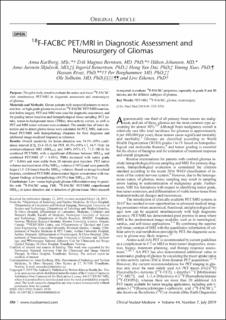18F-FACBC PET/MRI in diagnostic assessment and neurosurgery of gliomas
Karlberg, Anna Maria; Berntsen, Erik Magnus; Johansen, Håkon; Skjulsvik, Anne Jarstein; Reinertsen, Ingerid; Hong, Yan Dai; Xiao, Yiming; Rivaz, Hassan; Borghammer, Per; Solheim, Ole; Eikenes, Live
Peer reviewed, Journal article
Published version
Permanent lenke
https://hdl.handle.net/11250/2721496Utgivelsesdato
2019Metadata
Vis full innførselSamlinger
- Publikasjoner fra CRIStin - SINTEF AS [5866]
- SINTEF Digital [2536]
Sammendrag
Purpose: This pilot study aimed to evaluate the amino acid tracer 18F-FACBC
with simultaneous PET/MRI in diagnostic assessment and neurosurgery
of gliomas.
Materials and Methods: Eleven patients with suspected primary or recurrent low- or high-grade glioma received an 18F-FACBC PET/MRI examination before surgery. PET and MRI were used for diagnostic assessment, and
for guiding tumor resection and histopathological tissue sampling. PET uptake, tumor-to-background ratios (TBRs), time-activity curves, as well as
PET and MRI tumor volumes were evaluated. The sensitivities of lesion detection and to detect glioma tissue were calculated for PET, MRI, and combined PET/MRI with histopathology (biopsies for final diagnosis and
additional image-localized biopsies) as reference.
Results: Overall sensitivity for lesion detection was 54.5% (95% confidence interval [CI], 23.4–83.3) for PET, 45.5% (95% CI, 16.7–76.6) for
contrast-enhanced MRI (MRICE), and 100% (95% CI, 71.5–100.0) for
combined PET/MRI, with a significant difference between MRICE and
combined PET/MRI (P = 0.031). TBRs increased with tumor grade
(P = 0.004) and were stable from 10 minutes post injection. PET tumor
volumes enclosed most of the MRICE volumes (>98%) and were generally
larger (1.5–2.8 times) than the MRICE volumes. Based on image-localized
biopsies, combined PET/MRI demonstrated higher concurrence with malignant findings at histopathology (89.5%) than MRICE (26.3%).
Conclusions: Low- versus high-grade glioma differentiation may be possible with 18F-FACBC using TBR. 18F-FACBC PET/MRI outperformed
MRICE in lesion detection and in detection of glioma tissue. More research
is required to evaluate 18F-FACBC properties, especially in grade II and III
tumors, and for different subtypes of gliomas.

